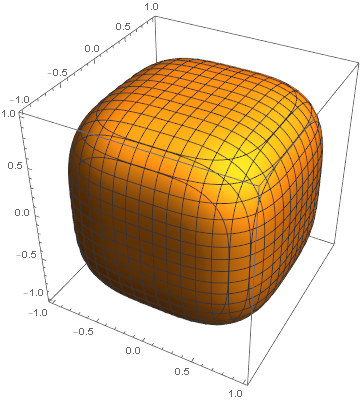The previous post looked at what exponent makes the area of a squircle midway between the area of a square and circle of the same radius. We could ask the analogous question in three dimensions, or in any dimension.
(What do you call a shape between a cube and a sphere? A cuere? A sphube?)

In more conventional mathematical terminology, higher dimensional squircles are balls under Lp norms. The unit ball in n dimensions under the Lp norm has volume
We’re asking to solve for p so the volume of a p-norm ball is midway between that of 2-norm ball and an ∞-norm ball. We can compute this with the following Mathematica code.
v[p_, n_] := 2^n Gamma[1 + 1/p]^n / Gamma[1 + n/p]
Table[
FindRoot[
v[p, n] - (2^n + v[2, n])/2,
{p, 3}
],
{n, 2, 10}
]
This shows that the value of p increases steadily with dimension:
3.16204
3.43184
3.81881
4.33311
4.96873
5.70408
6.51057
7.36177
8.23809
We saw the value 3.16204 in the previous post. The result for three dimensions is 3.43184, etc. The image above uses the solution for n = 3, and so it has volume halfway between that of a sphere and a cube.
In order to keep the total volume midway between that of a cube and a sphere, p has to increase with dimension, making each 2-D cross section more and more like a square.
Here’s the Mathematica code to draw the cuere/sphube.
p = 3.43184
ContourPlot3D[
Abs[x]^p + Abs[y]^p + Abs[z]^p == 1,
{x, -1, 1},
{y, -1, 1},
{z, -1, 1}
]

What about each axis having a different squircle?
How would you form the “squircley” surface?
Is a solution for the circumference known? I accidentally found it for an L3 norm and Mathematica. https://math.stackexchange.com/questions/2775760/non-integral-representations-of-circumferences-of-lp-norm-unit-circles-for-p-ge
I believe that in general the arc length integral cannot be evaluated in closed form, though it could have a closed form for some integer exponents.
What do you call a shape between a cube and a sphere?
A hexaspheron.
If “spherical” and “globular” may considered equal (for example when referring to the shape of powder particles) then globe and cube melt into “glube” (not coined in 1966 but a later idea of mine).
Glube is also intuitively depictive of the shape of glube marshmallows and glube Italian gnocchi.
A more common technique for rounding corners of shapes and solids in computer graphics is to use a subdivision surface (which applies a hierarchical averaging to smooth edges and vertices).
http://www.holmes3d.net/graphics/subdivision/
A a side issue, the ratio of V to SA of a sphere is 3/r and the ratio of the circumscribing (enclosing) cube is also 3/r, so I’m interested to know how this ratio might transition as a “sphube” from the two end points of a sphere and a cube. Does it minimise between the two ends? Does anyone know?